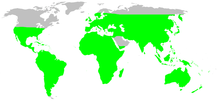Long-legged sac spider
| Long-legged sac spiders | |
|---|---|
 | |
| Cheiracanthium sp. | |
 | |
| C. inclusum eye pattern | |
| Scientific classification | |
| Kingdom: | Animalia |
| Phylum: | Arthropoda |
| Class: | Arachnida |
| Order: | Araneae |
| Section: | Entelegynae |
| Superfamily: | incertae sedis |
| Family: | Miturgidae Simon, 1885 |
| Genera | |
|
Cheiracanthium | |
| Diversity | |
| 26 genera, 351 species | |
 | |
| Wikispecies has information related to: Miturgidae |
The long-legged sac spiders (family Miturgidae) include nearly 400 species in about 30 genera worldwide.
The largest genus currently recognized as belonging to this family is Cheiracanthium, which used to be placed in the family of "true" sac spider, Clubionidae. The placement of the primarily Old World genus Cheiracanthium in the Miturgidae family is still being debated and may change. Only two species are known from the United States, one of which is obviously introduced. The genus is quite diverse in Africa and at least three or four species are known to occur in Egyptian cotton fields alone. The family would be totally obscure if it were not for the fact that members of Cheiracanthium are documented beneficial predators in agricultural fields and are also known to be mildly venomous to humans. The yellow sac spider, Cheiracanthium inclusum, has been studied more than the other species in regard to its role in controlling pest insects in the southeastern United States. Other genera include the more obscure southwestern US and Mexican Syspira, which superficially resembles a wolf spider (Family Lycosidae). The mostly tropical New World genus Teminius is noted for the thick velcro-like scopula on the undersides of the tarsi.
Genera
The categorization into subfamilies follows Raven (2009)[1] with the exception of the Systariinae and Eutichurinae which were explicitly excluded by Raven (2009)[2] and by Deeleman-Reinhold (2001).
- Eutichurinae
- Calamoneta Deeleman-Reinhold, 2001 (Sumatra, Java)
- Calamopus Deeleman-Reinhold, 2001 (Thailand, Indonesia)
- Cheiracanthium C. L. Koch, 1839 (Holarctic, Africa, Australia)
- Cheiramiona Lotz & Dippenaar-Schoeman, 1999 (Africa)
- Ericaella Bonaldo, 1994 (South America to Panama)
- Eutichurus Simon, 1897 (South America to Costa Rica)
- Helebiona Benoit, 1977 (St. Helena)
- Macerio Simon, 1897 (Chile, Argentina)
- Radulphius Keyserling, 1891 (Brazil, Guyana)
- Summacanthium Deeleman-Reinhold, 2001 (Sulawesi)
- Tecution Benoit, 1977 (St. Helena)
- Miturginae
- Miturga Thorell, 1870 (Australia, New Guinea)
- Prochora Simon, 1885 (Sicily, Israel)
- Syrisca Simon, 1885 (Africa, South America)
- Syspira Simon, 1895 (USA, Mexico)
- Teminius Keyserling, 1887 (USA to Argentina)
- Systariinae
- Palicanus Thorell, 1897 (Southeast Asia)
- Strotarchus Simon, 1888 (USA to Mexico, Costa Rica, Brazil, Pakistan)
- Systaria Simon, 1897 (Southeast Asia)
- Tamin Deeleman-Reinhold, 2001 (Borneo, Sulawesi)
- Xantharia Deeleman-Reinhold, 2001 (Borneo, Sumatra)
- Diaprograptinae Raven, 2009
- Diaprograpta Simon, 1909 (Australia)
- Eupograpta Raven, 2009 (Australia)
- Mituliodon Raven & Stumkat, 2003 (Timor, Australia)
- Mitzoruga Raven, 2009 (Australia)
- Nuliodon Raven, 2009 (Australia)
- Zealoctenus Forster & Wilton, 1973 (New Zealand)
- Pacificana Hogg, 1904 (New Zealand)
- Parapostenus Lessert, 1923 (South Africa)
See also
- List of Miturgidae species
- Spider families
References
- ↑ Raven, R.J. 2009. Revisions of Australian ground-hunting spiders: IV. The spider subfamily Diaprograptinae subfam. nov. (Araneomorphae: Miturgidae). Zootaxa 2035: 1-40
- ↑ Raven, R.J. 2009. Revisions of Australian ground-hunting spiders: IV. The spider subfamily Diaprograptinae subfam. nov. (Araneomorphae: Miturgidae). Zootaxa 2035: 1-40.
External links
| Wikimedia Commons has media related to Miturgidae. |
- Arachnology Home Pages: Araneae
- Platnick, N.I. 2003. World Spider Catalog
- Photos of Australian Sac Spiders
- Fact Sheet on Sac Spiders
| |||||||||||||||||||